
Odile of Alsace, also known as Odilia and Ottilia, born c. 662 - c. 720 at Mont Sainte-Odile), is a saint venerated in the Roman Catholic Church and the Orthodox Church. The current Roman Catholic liturgical calendar does not officially commemorate her feast day of 13 December, but she is commemorated on this day in the Orthodox Church. She is a patroness saint of good eyesight, and of Alsace.

Altorf is a commune in the Bas-Rhin department in the Grand Est region of northeastern France.
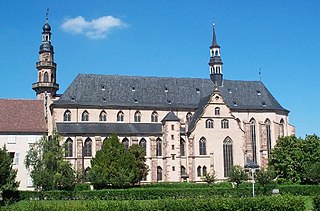
Molsheim is a commune in the Bas-Rhin department in Grand Est in north-eastern France. The total population in 2017 was 9,312. Molsheim had been a very fast-growing city between the French censuses of 1968 and 1999, passing from 5,739 to 9,335 inhabitants, but this increase came to a noticeable halt since. The urban unit of Molsheim had 26,925 inhabitants in 2017, from 16,888 in 1968. Molsheim is part of the urban area of Strasbourg.
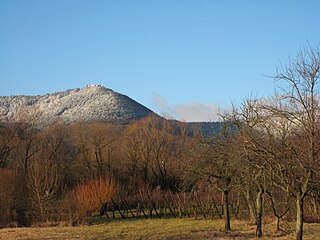
Mont Sainte-Odile is a 764-metre-high peak in the Vosges Mountains in Alsace in France, immediately west of Barr. The mountain is named after Saint Odile. It has a monastery/convent at its top called the Hohenburg Abbey, and is notable also for its stone fortifications called "the Pagan Wall." In 1992, Air Inter flight 148 crashed near this area.

Mont Sainte-Odile Abbey, also known as Hohenburg Abbey, is a nunnery, situated on Mont Sainte-Odile, one of the most famous peaks of the Vosges mountain range in the French region of Alsace.

Lièpvre is a commune in the Haut-Rhin department in Grand Est in north-eastern France. A monastery was built here in the eighth century by Saint Fulrad, who filled it with relics of Saint Cucuphas and Saint Alexander.

Andlau is a commune in the Bas-Rhin department in the Alsace region of northeastern France.

The Roman Catholic Diocese of Saint-Dié (Latin: Dioecesis Sancti Deodatiis; French: Diocèse de Saint-Dié is a diocese of the Latin Rite of the Roman Catholic Church in France. The diocese has the same boundaries as the department of the Vosges. The bishop has his throne at Saint-Dié Cathedral in the town now named Saint-Dié-des-Vosges, but since 1944 has lived in Épinal, capital of the département. The diocese is currently a suffragan of the Archdiocese of Besançon. The current bishop is Jean-Paul Marie Mathieu, who was appointed in December 2005.

Chelles Abbey was a Frankish monastery founded c. 658 during the early medieval period. It was intended initially as a monastery for women; then its reputation for great learning grew, and with the afflux of men wishing to follow the monastic life, a parallel male community was established, creating a double monastery.

Avolsheim is a commune in the Bas-Rhin department in the Grand Est region of north-eastern France.

Kintzheim is a commune in the Bas-Rhin department in Alsace in north-eastern France.
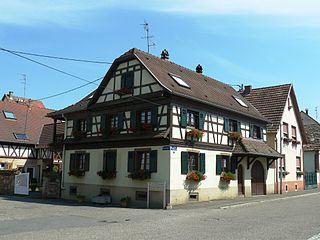
Krautergersheim is a commune in the Bas-Rhin department in Alsace in north-eastern France. It lies between Strasbourg and Obernai.
Honcourt Abbey or Hugshofen Abbey was a Benedictine abbey located near the village of Saint-Martin, Bas-Rhin, founded in the year 1000 and dissolved in or very shortly after 1525.

Andlau Abbey was a women's collegiate foundation for secular canonesses located at Andlau in Alsace, eastern France.

The Route Romane d'Alsace is a tourist itinerary designed by the Association Voix et Route Romane to link both the well-known and the more secret examples of Romanesque architecture of Alsace, in an itinerary of 19 stages, linking churches, abbeys and fortresses, that range from the first Romanesque structures of Alsace at the abbey church of Saint Trophime, Eschau, into the 13th century, and the beginning of Gothic architecture in Alsace. From north to south, the Route Romane d'Alsace traverses the Bas-Rhin and the Haut-Rhin, passing through:
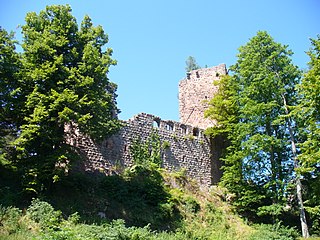
The Château du Landsberg is a castle in the commune of Heiligenstein in the Bas-Rhin département in Alsace, France.

December 12 - Eastern Orthodox liturgical calendar - December 14
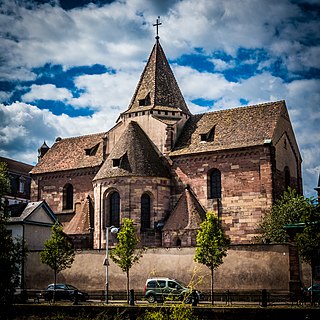
Saint Stephen’s Church in Strasbourg is located inside the catholic ‘Saint-Étienne’ college in Strasbourg, for which it serves as a chapel.
The Abbey of Honau was a monastic foundation in Northern Alsace which flourished from the 8th century until 1290, when it succumbed to the flood-waters of the Rhine.

Saint Trophimus' Church is a Romanesque church in Eschau, a small town in the suburbs of Strasbourg, the historical capital of Alsace. The church is dedicated to Trophimus of Arles.




















